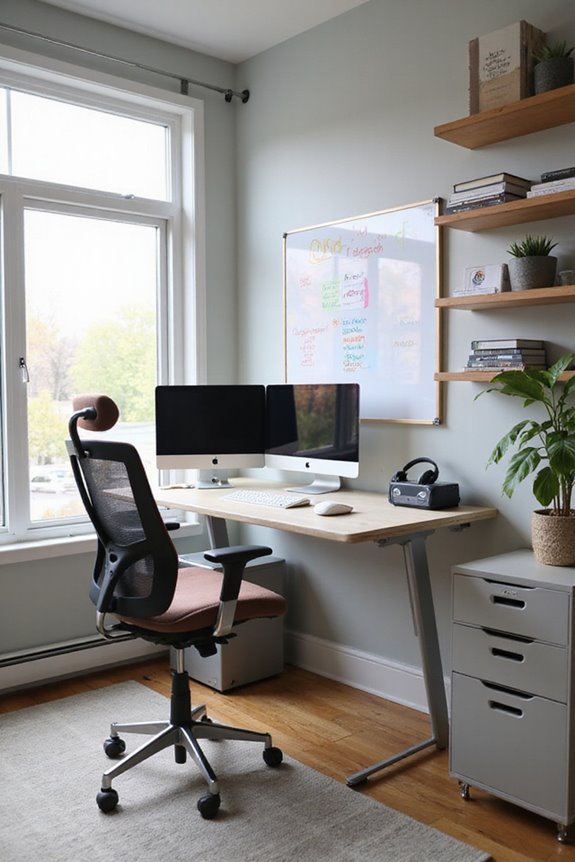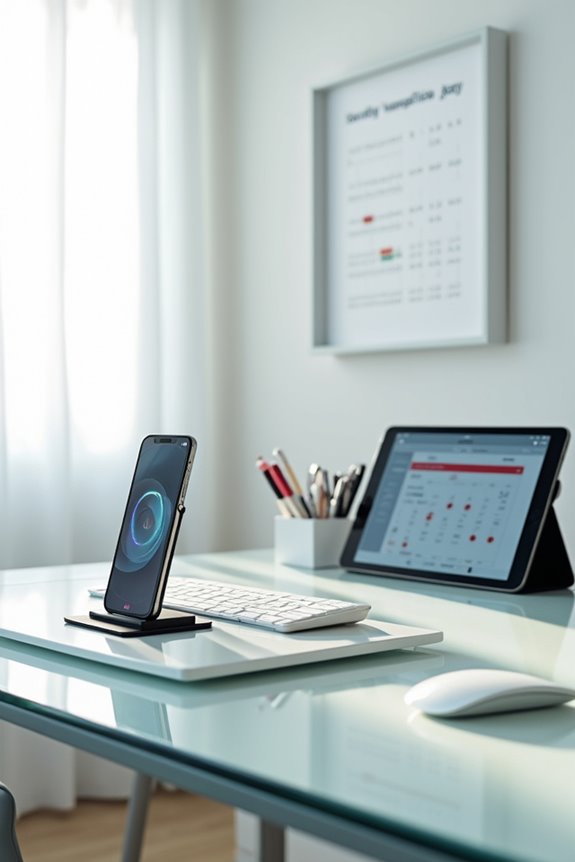To enhance productivity in home offices, I’ve found that using the right tools is vital. Tools like Slack for messaging and Zoom for meetings help keep communication flowing. Implementing strategies, such as time blocking and prioritizing tasks, allows me to focus effectively. Creating an ideal workspace, with ergonomic furniture and good lighting, is essential too. Additionally, fostering a supportive remote work culture through regular check-ins and open communication can greatly boost morale. There’s more to explore on achieving productivity.
Key Takeaways
- Utilize project management tools like ClickUp or Asana for task organization and automation in home office settings.
- Implement time blocking techniques to allocate specific time slots for focused work on tasks.
- Foster regular virtual meetings using platforms like Zoom to maintain team communication and collaboration.
- Invest in ergonomic furniture and a distraction-free workspace to enhance comfort and productivity.
- Use communication tools like Slack for real-time messaging and to integrate various applications for streamlined workflow.
Effective Tools for Remote Work Productivity
How can we enhance our productivity while working from home? One effective approach is to utilize the right tools for remote communication and project management. For real-time messaging, I recommend Slack, which seamlessly integrates with various applications. Zoom is excellent for video meetings, ensuring that collaboration remains robust. Microsoft Teams is ideal if your organization uses Office 365, while Google Meet offers convenience with Google Calendar integration.
When it comes to project management, ClickUp provides a customizable workspace, while Asana excels in automation. Trello is perfect for visual task management, and Jira is suitable for more complex projects. By leveraging these tools, we can streamline our workflows and improve our overall productivity while working remotely.
Strategies to Enhance Focus and Efficiency

Maximizing productivity while working from home requires more than just the right tools; it involves implementing effective strategies that enhance focus and efficiency. One of the most impactful methods I’ve found is time blocking. By allocating specific time slots for tasks, I can concentrate fully, minimizing distractions and improving my output.
Additionally, task prioritization plays an essential role in managing my workload. I identify urgent and important tasks first, which helps me stay organized and focused. To further enhance productivity, I make it a point to take regular breaks. This practice recharges my mind and prevents burnout, ensuring I remain efficient throughout the day. Implementing these strategies has made a significant difference in my work-from-home experience. Incorporating durable materials into my desk setup, such as metal mesh organizers, also contributes to a more organized and efficient workspace.
Creating an Optimal Home Office Environment

Creating an ideal home office environment is essential for enhancing productivity and maintaining well-being. First, invest in ergonomic furniture to support your long-term health and comfort. A well-fitted desk and chair can prevent discomfort during long work hours. Next, maximize natural lighting as it’s important for reducing stress and boosting mood. Incorporating biophilic design elements, such as plants, not only beautifies your space but also enhances creativity and lowers anxiety. Additionally, it’s important to carve out personal space for focused work. This could be a quiet nook or a dedicated room, ensuring you have a distraction-free zone. By thoughtfully designing your home office, you can create a productive and enjoyable working atmosphere that meets your needs. Moreover, investing in ergonomic chairs can significantly improve your posture and overall comfort during long work sessions.
Overcoming Common Remote Work Challenges

Steering through the challenges of remote work can feel overwhelming, especially when distractions and a lack of structure threaten to undermine productivity. To tackle distraction management, I’ve found that implementing productivity tools like website blockers helps minimize interruptions. Establishing a designated workspace and adhering to scheduled work hours can greatly improve focus.
Routine establishment is equally critical. Setting clear daily goals keeps my tasks organized, while allowing for flexible scheduling accommodates my peak productivity times. Cultivating self-discipline and setting boundaries between work and personal life are essential for maintaining a consistent routine. Regular check-ins with colleagues also foster accountability and keep me engaged. By employing these strategies, I can effectively overcome common remote work challenges. Additionally, incorporating ergonomic workspaces can significantly enhance comfort and productivity during long work hours.
Building a Supportive Remote Work Culture

Building a supportive remote work culture is essential for fostering employee satisfaction and engagement. To achieve this, focus on enhancing remote communication. Regular virtual meetings create a sense of community, ensuring that everyone feels connected. Aligning your team with shared goals strengthens their commitment to the organization, promoting engagement.
Additionally, establishing open communication channels allows team members to voice concerns and suggestions freely. Regular check-ins are crucial to monitor well-being and address issues promptly. Don’t forget the importance of feedback and recognition; acknowledging achievements boosts morale.
Lastly, encourage a healthy work-life balance to prevent burnout, and implement well-being programs that cater to mental health. A supportive culture is key to retaining talent and maintaining productivity in remote settings.
Frequently Asked Questions
How Can I Maintain Work-Life Balance While Working From Home?
When I first worked from home, my couch became my office. I quickly learned to set clear work hours and create personal space, helping me maintain balance and avoid blending work with my home life.
What Are the Best Practices for Setting Remote Work Boundaries?
Setting personal boundaries in my remote workspace is essential. I schedule dedicated work hours, communicate availability clearly, and minimize distractions. This balance helps me stay productive while enjoying my personal life without constant interruptions.
How Can I Motivate Myself During Remote Work?
Think of motivation as a flame; it needs fuel. I find goal setting and daily routines ignite my fire, keeping me focused and engaged while working remotely. Small wins light the way through my day.
What Are the Signs of Remote Work Burnout?
I’ve noticed signs of burnout in my remote work, like constant fatigue, irritability, and difficulty concentrating. If you’re feeling overwhelmed or withdrawing from colleagues, it’s essential to prioritize your mental health and seek support.
How Should I Manage Time Zones With Remote Teams?
Managing time zones with remote teams is essential. I rely on scheduling tools like Calendly for time zone coordination, ensuring we find overlap hours. It really enhances our collaboration and keeps everyone engaged without stress.





